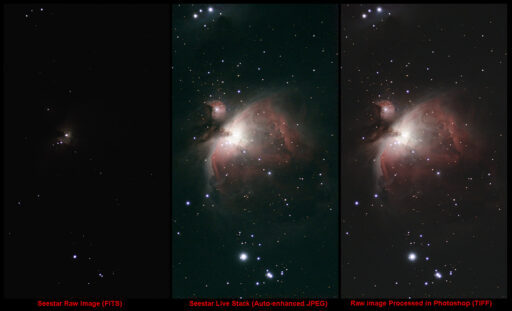
M42, The Great Nebula in Orion, Seestar S50, 10s x 30m
This is a quick example from my shake-down tests with the Seestar S50. The image on the left was the raw live stack saved as a FITS and converted to a TIFF using Nebulosity. This preserves all of the source data from the live stack in a lossless format suitable for later processing and analysis. The middle image is the displayed real-time live stack showing the enhanced image which is saved as full-scale and thumbnail JPEG. The image on the right is the same data as the source image on the left, but processed using Photoshop, saved as a TIFF and finally as a JPEG. The illustrates that the Seestar does a great job grading, aligning and combining the source images, and saving a high-quality raw image in a lossless format. This is not only handy for later processing but does a great job showing what an object really looks like before the image is processed. The real-time enhanced image looks excellent and in some ways a tad better than my processed image (primarily a bit better contrast than my processed image, though that’s a matter of taste). And finally, the processed example shows that the raw live stack is well suited for stand-alone processing. For my initial evaluation I was also saving all of the raw source images so that I could stack them myself, but so far, I have found that the live stacked image works so well I no longer save the individual source images unless I have a specific interest in doing so.
Next up… I am going to see if I can pull photometric data from the raw live stack. The Seestar is so capable and easy to use it should make an excellent platform for obtaining photometric images of variable stars and asteroids. I’m hoping that ZWO adds a user-defined target capability to the app to make it easier to locate objects that are not in the current database.
There’s always one more thing! 🙂
Enjoy!
Recent Comments